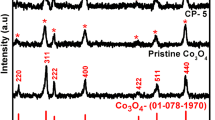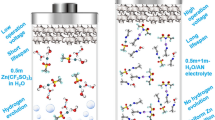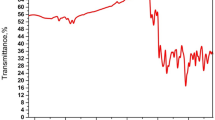Abstract
Phase pure lithium trivanadate (LiV3O8) was synthesized by an ultrasound-assisted rheological phase reaction method for aqueous supercapacitor applications. The precursor was exposed to ultrasound for different time periods of 2, 6 and 10 h and then calcined under similar conditions. The effects of ultrasound on the structural features of the synthesized samples was characterized by XRD, and FTIR spectroscopy and the morphological features by SEM analysis. The sample synthesized by exposing the precursor to ultrasound for 10 h showed a high value of d100spacing, which facilitated the lithium (Li+) ion movement. Also, the formation of rod-like structures by the exposure of ultrasound facilitated the fast Li+ ion movement and enhanced the electrochemical performance. The electrochemical performance was measured using a three-electrode cell setup in the potential range of −0.8 to 0.2 V using 1 M LiNO3aqueous electrolyte. The specific capacitance of the material was found to be 120 F/g at a current density of 1A/g for the sample sonicated for 10 h (10S-LVO). The symmetric supercapacitor constructed using 10S-LVO showed the highest specific capacitance of 317F/g at 0.5 A/g, with 66.28% capacitance retention at 1A/g after 150 cycles.
Graphical Abstract
Effect of ultrasound on the morphology of LiV3O8










Similar content being viewed by others
References
G. Zhou, F. Li, and H.M. Cheng, Progress in flexible lithium batteries and future prospects. Energy Environ. Sci. 7(4), 1307–1338 (2014). https://doi.org/10.1039/c3ee43182g.
S. Chen, L. Ma, K. Zhang, M. Kamruzzaman, C. Zhi, and J.A. Zapien, A flexible solid-state zinc ion hybrid supercapacitor based on Co-polymer derived hollow carbon spheres. J. Mater. Chem. A 7(13), 7784–7790 (2019). https://doi.org/10.1039/C9TA00733D.
W. Zhang, Y. Liu, C. Chen, Z. Li, Y. Huang, and X. Hu, Flexible and binder-free electrodes of Sb/RGO and Na3V2(PO4)3/RGO nanocomposites for sodium-ion batteries. Small 11(31), 3822–3829 (2015). https://doi.org/10.1002/smll.201500783.
W.J. Song, S. Lee, G. Song, H.B. Son, D.Y. Han, I. Jeong, Y. Bang, and S. Park, Recent progress in aqueous based flexible energy storage devices. Energy Storage Mater. 30, 260–286 (2020). https://doi.org/10.1016/j.ensm.2020.05.006.
J. Yan, Q. Wang, T. Wei, and Z. Fan, Recent advances in design and fabrication of electrochemical supercapacitors with high energy densities. Adv. Energy Mater. (2014). https://doi.org/10.1002/aenm.201300816.
P. Bhojane, Recent advances and fundamentals of pseudocapacitors: materials, mechanism, and its understanding. J. Energy Storage 45, 103654 (2022). https://doi.org/10.1016/j.est.2021.103654.
A.D. Wadsley, Crystal chemistry of non-stoichiometric pentavalent vandadium oxides: crystal structure of Li1+xV3O8. Acta Crystallogr. (1957). https://doi.org/10.1107/S0365110X57000821.
J. Zheng, Y. Zhang, N. Wang, Y. Zhao, F. Tian, and C. Meng, Facile synthesis and characterization of LiV3O8 with sheet-like morphology for high-performance supercapacitors. Mater. Lett. 171, 240–243 (2016). https://doi.org/10.1016/j.matlet.2016.02.095.
J. Liu, W. Liu, Y. Wan, S. Ji, J. Wang, and Y. Zhou, Facile synthesis of layered LiV3O8 hollow nanospheres as superior cathode materials for high-rate Li-Ion batteries. RSC Adv. 2(28), 10470–10474 (2012). https://doi.org/10.1039/c2ra20969a.
J. Liu, L. Yi, L. Liu, and P. Peng, LiV3O8 nanowires with excellent stability for aqueous rechargeable lithium batteries. Mater. Chem. Phys. 161, 211–218 (2015). https://doi.org/10.1016/j.matchemphys.2015.05.038.
W. Li, L. Zhu, Z. Yu, L. Xie, and X. Cao, Enhanced electrochemical performances as cathode materials for rechargeable lithium batteries. Materials (2017). https://doi.org/10.3390/ma10040344.
Y.C. Si, L.F. Jiao, H.T. Yuan, H.X. Li, and Y.M. Wang, Structural and electrochemical properties of LiV3O8 prepared by combustion synthesis. J. Alloys Compd. 486(1–2), 400–405 (2009). https://doi.org/10.1016/j.jallcom.2009.06.188.
S. Huang, Y. Lu, T.Q. Wang, C.D. Gu, X.L. Wang, and J.P. Tu, Polyacrylamide-assisted freeze drying synthesis of hierarchical plate-arrayed LiV3O8 for high-rate lithium-ion batteries. J. Power Sources 235, 256–264 (2013). https://doi.org/10.1016/j.jpowsour.2013.02.031.
H. Song, Y. Liu, C. Zhang, C. Liu, and G. Cao, Ion batteries. J. Mater. Chem. A Mater. Energy Sustain. (2015). https://doi.org/10.1039/C4TA05616G.
M. Arinawati, A.P. Hutama, C.S. Yudha, M. Rahmawati, and A. Purwanto, Facile rheological route method for LiFePO4/C cathode material production. Open Eng. 11(1), 669–676 (2021). https://doi.org/10.1515/eng-2021-0068.
C. Ai, M. Yin, C. Wang, and J. Sun, Synthesis and characterization of spinel type ZnCo2O4 as a novel. J. Mater. Sci. 39, 1077–1079 (2004).
Y. Liang, S. Yang, Z. Yi, M. Li, J. Sun, and Y. Zhou, Rheological phase synthesis and electrochemical performances of LiVMoO6 as a high-capacity anode material for lithium ion batteries. J. Mater. Sci. 40(20), 5553–5555 (2005). https://doi.org/10.1007/s10853-005-4549-0.
H. Liu, S.H. Luo, D.X. Zhang, D.B. Hu, T.F. Yi, Z.Y. Wang, Y.H. Zhang, Y.G. Liu, Q. Wang, A.M. Hao et al., A simple and low-cost method to synthesize Cr-doped α-Fe2O3 electrode materials for lithium-ion batteries. ChemElectroChem 6(3), 856–864 (2019). https://doi.org/10.1002/celc.201801736.
H. Liu, L. Liu, and C. Ding, A quick microwave-assisted rheological phase reaction route for preparing Cu3Mo2O9 with excellent lithium storage and supercapacitor performance. J. Alloys Compd. 867, 159061 (2021). https://doi.org/10.1016/j.jallcom.2021.159061.
S. Zhong, W. Chen, L. Wu, and J. Liu, A PEG-assisted rheological phase reaction synthesis of 5LiFePO4{dot Operator}Li3V2(PO4) 3/C as cathode material for lithium ion cells. Ionics (Kiel) 18(5), 523–527 (2012). https://doi.org/10.1007/s11581-012-0701-4.
J.J. Hinman, and K.S. Suslick, Nanostructured materials synthesis using ultrasound. Top. Curr. Chem. 375(1), 1–36 (2017). https://doi.org/10.1007/s41061-016-0100-9.
Z. Li, J. Dong, L. Wang, Y. Zhang, T. Zhuang, H. Wang, X. Cui, and Z. Wang, A power-triggered preparation strategy of nano-structured inorganics: sonosynthesis. Nanoscale Adv. 3(9), 2423–2447 (2021). https://doi.org/10.1039/d1na00038a.
H.J. Kim, J.M. Kim, W.S. Kim, H.J. Koo, D.S. Bae, and H.S. Kim, Synthesis of LiFePO4/C cathode materials through an ultrasonic-assisted rheological phase method. J. Alloys Compd. 509(18), 5662–5666 (2011). https://doi.org/10.1016/j.jallcom.2011.02.113.
N. Dharmalingam, S. Rajagopal, P. Veluswamy, S. Paulraj, and V. Kathirvel, Facile microwave synthesis of Sn-doped WO3 for pseudocapacitor applications. J. Mater. Sci. Mater. Electron. 33(12), 9246–9255 (2022). https://doi.org/10.1007/s10854-021-07249-8.
R. Rajavaram, K. Sivaiah, and S. Buddhudu, Structural and dielectric properties of LiV3O8 ceramic powders structural and dielectric properties of LiV3O8 ceramic powders. Ferroelectrics (2012). https://doi.org/10.1080/00150193.2012.707843.
D. Wang, L. Cao, J. Huang, and J. Wu, Synthesis and electrochemical properties of LiV3O8 via an improved sol-gel process. Ceram. Int. 38(4), 2647–2652 (2012). https://doi.org/10.1016/j.ceramint.2011.11.030.
L. Liu, L. Jiao, Y. Zhang, J. Sun, L. Yang, Y. Miao, H. Yuan, and Y. Wang, Synthesis of LiV3O8 by an improved citric acid assisted sol-gel method at low temperature. Mater. Chem. Phys. 111, 565–569 (2008). https://doi.org/10.1016/j.matchemphys.2008.05.013.
T. Partheeban, and M. Sasidharan, Materials template-free synthesis of LiV3O8 hollow microspheres as positive electrode for Li-Ion batteries. J. Mater. Sci. (2019). https://doi.org/10.1007/s10853-019-04086-3.
A.M. Teli, S.A. Beknalkar, S.A. Pawar, and D.P. Dubal, Effect of concentration on the charge storage kinetics of nanostructured MnO2 thin-film supercapacitors synthesized by the hydrothermal method. Energies 13(22), 6124 (2020).
A. Cymann-Sachajdak, M. Graczyk-Zajac, G. Trykowski, and M. Wilamowska-Zawłocka, Understanding the capacitance of thin composite films based on conducting polymer and carbon nanostructures in aqueous electrolytes. Electrochim. Acta 383, 138356 (2021). https://doi.org/10.1016/j.electacta.2021.138356.
Z.H. Huang, T.Y. Liu, Y. Song, Y. Li, and X.X. Liu, Balancing the electrical double layer capacitance and pseudocapacitance of hetero-atom doped carbon. Nanoscale 9(35), 13119–13127 (2017). https://doi.org/10.1039/c7nr04234e.
Y. Chang, H. Shi, X. Yan, G. Zhang, and L. Chen, A ternary B, N, P-doped carbon material with suppressed water splitting activity for high-energy aqueous supercapacitors. Carbon N. Y. 170, 127–136 (2020). https://doi.org/10.1016/j.carbon.2020.08.013.
S. Pavithra, S.P. Keerthana, R. Yuvakumar, P.S. Kumar, S. Rajesh, and A. Sakunthala, Preparation of β-FeOOH by ultrasound assisted precipitation route for aqueous supercapacitor applications. Inorg. Nano-Metal Chem. (2021). https://doi.org/10.1080/24701556.2021.1988978.
A. Sakunthala, M.V. Reddy, S. Selvasekarapandian, B.V.R. Chowdari, H. Nithya, and P.C. Selvin, Synthesis and electrochemical studies on LiV3O8. J. Solid State Electrochem. 14(10), 1847–1854 (2010). https://doi.org/10.1007/s10008-010-1044-6.
Y.J. Hao, Q.Y. Lai, L. Wang, X.Y. Xu, and H.Y. Chu, Electrochemical performance of a high cation-deficiency Li2Mn4O9/active carbon supercapacitor in LiNO3 electrolyte. Synth. Met. 160(7–8), 669–674 (2010). https://doi.org/10.1016/j.synthmet.2009.12.025.
C. Chang, J.Y. Kim, and P.N. Kumta, Influence of crystallite size on the electrochemical property of chemically synthesized LiNiO2 influence of crystallite size on the electrochemical properties of chemically synthesized stoichiometric LiNiO2. J. Electrochem. Soc. (2002). https://doi.org/10.1149/1.1495495.
L. Xie, Y. Xu, J. Zhang, C. Zhang, X. Cao, and L. Qu, Rheological phase synthesis of Er-doped LiV3O8 as electroactive material for a cathode of secondary lithium storage. Electron. Mater. Lett. 9(4), 549–553 (2013). https://doi.org/10.1007/s13391-013-2189-0.
Y. Zhang, J. Zheng, Y. Zhao, T. Hu, Z. Gao, and C. Meng, Fabrication of V2O5 with various morphologies for high-performance electrochemical capacitor. Appl. Surf. Sci. 377, 385–393 (2016). https://doi.org/10.1016/j.apsusc.2016.03.180.
J. Jiang, J. Liu, S. Peng, D. Qian, D. Luo, Q. Wang, Z. Tian, and Y. Liu, Facile synthesis of α-MoO3 nanobelts and their pseudocapacitive behavior in an aqueous Li2SO4 solution. J. Mater. Chem. A 1(7), 2588–2594 (2013). https://doi.org/10.1039/c2ta01120d.
S. Alagar, R. Madhuvilakku, R. Mariappan, and S. Piraman, Nano-architectured porous Mn2O3 spheres/cubes versus RGO for asymmetric supercapacitors applications in novel solid-state electrolyte. J. Power Sources (2019). https://doi.org/10.1016/j.jpowsour.2019.227181.
Z. Yin, J. Xu, Y. Ge, Q. Jiang, Y. Zhang, Y. Yang, Y. Sun, S. Hou, Y. Shang, and Y. Zhang, Synthesis of V2O5 microspheres by spray pyrolysis as cathode material for supercapacitors. Mater. Res. Express 5(3), 36306 (2018). https://doi.org/10.1088/2053-1591/aab424.
Acknowledgments
The authors thank the following funding agencies for the instrument facilities. The authors are grateful to the Department of Atomic Energy, Board of Research in Nuclear Sciences (DAE-BRNS Project No.: 1221/34/32/2012).The authors thank the Department of Science and Technology, Science and Engineering Research Board, DST-SERB Project No. EMR/2017/003227dated 16 July 2018.
Author information
Authors and Affiliations
Corresponding author
Ethics declarations
The authors declare that they have no conflicts of interest in this work.
Additional information
Publisher's Note
Springer Nature remains neutral with regard to jurisdictional claims in published maps and institutional affiliations.
Rights and permissions
Springer Nature or its licensor (e.g. a society or other partner) holds exclusive rights to this article under a publishing agreement with the author(s) or other rightsholder(s); author self-archiving of the accepted manuscript version of this article is solely governed by the terms of such publishing agreement and applicable law.
About this article
Cite this article
Pavithra, S., Kathirvel, V., Rajesh, S. et al. Synthesis of LiV3O8 by an Ultrasound-Assisted Rheological Phase Reaction Method for Aqueous Supercapacitor Application. J. Electron. Mater. 52, 1794–1807 (2023). https://doi.org/10.1007/s11664-022-10108-9
Received:
Accepted:
Published:
Issue Date:
DOI: https://doi.org/10.1007/s11664-022-10108-9




